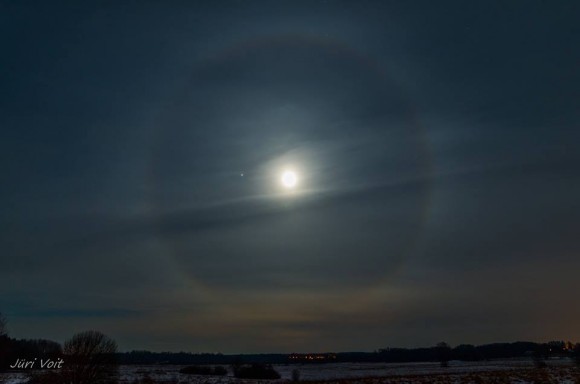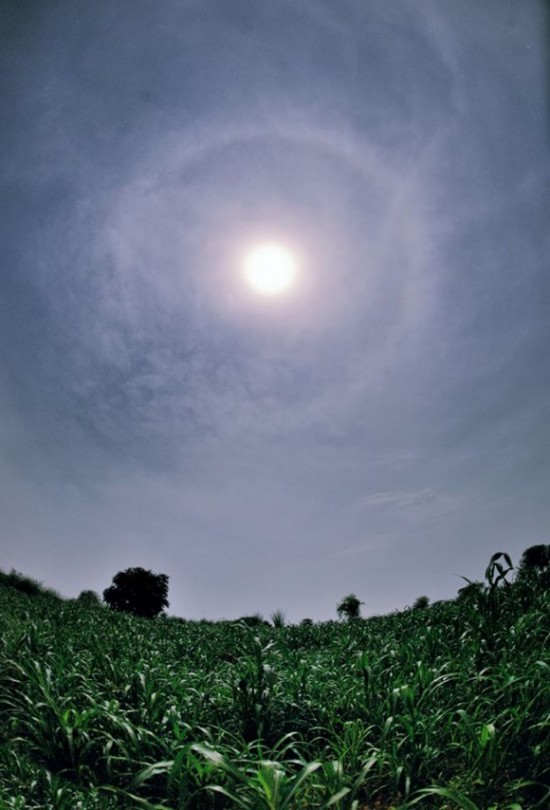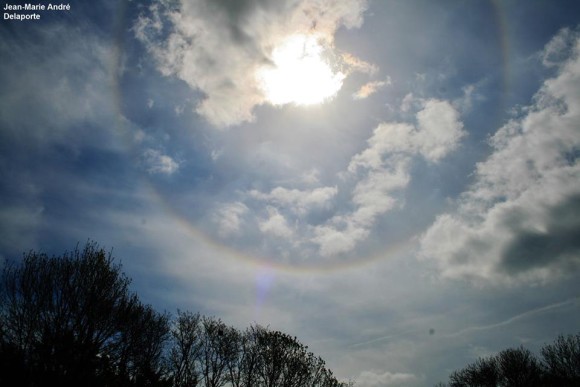Why a halo around the sun or moon?
A large ring or circle of light around the sun or moon is called a 22-degree halo by scientists.
Sun halo captured on June 5, 2016 by Amy Gray in Aiken, South Carolina.
We get many messages throughout each year from people who’ve just spotted a large ring or circle of light around the sun or moon. Scientists call them 22-degree halos. People just want to know, what causes these gigantic rings? Follow the links below to learn more about lunar and solar halos.
What makes a halo around the sun or moon?
If you see a halo, notice this!

Sheryl R. Garrison in Idaho caught the November 14, 2016 supermoon. She wrote: “I’ve caught lunar halos before but tonight was a first for me to catch one with an arc … The arc didn’t last for long, just enough time for me to grab the tripod.” By the way, this is a special type of 22-degree lunar halo, called a circumscribed halo.
What makes a halo around the sun or moon? There’s an old weather saying: ring around the moon means rain soon. There’s truth to this saying, because high cirrus clouds often come before a storm. Notice in these photos that the sky looks fairly clear. After all, you can see the sun or moon. And yet halos are a sign of high thin cirrus clouds drifting 20,000 feet or more above our heads.
These clouds contain millions of tiny ice crystals. The halos you see are caused by both refraction, or splitting of light, and also by reflection, or glints of light from these ice crystals. The crystals have to be oriented and positioned just so with respect to your eye, in order for the halo to appear.
That’s why, like rainbows, halos around the sun – or moon – are personal. Everyone sees their own particular halo, made by their own particular ice crystals, which are different from the ice crystals making the halo of the person standing next to you.
Why is it called a 22-degree halo? Because the ring has a radius of approximately 22° around the sun or moon.
Enjoying EarthSky so far? Sign up for our free daily newsletter today!

A moon halo in Mandan, North Dakota by Marshall Lipp. February, 2015.

Sun halo and sundogs. Captured 37,000 feet up, over Bhopal, India, on October 3, 2015. Photo by CB Devgun.

Doug Waters in New Bern, North Carolina caught this photo on February 4, 2015. He wrote: “High cyrus clouds from an approaching weather system presented the perfect opportunity for a halo to form around the sun, which appeared to be pierced by the con trail of a passing airliner.” Thanks for sharing your photo with EarthSky, Doug.
If you see a halo, notice this! Because moonlight isn’t very bright, lunar halos are mostly colorless, but you might notice more red on the inside and more blue on the outside of the halo. These colors are more noticeable in halos around the sun. If you do see a halo around the moon or sun, notice that the inner edge is sharp, while the outer edge is more diffuse. Also, notice that the sky surrounding the halo is darker than the rest of the sky.

Jupiter and full moon witin lunar halo on February 3, 2015. Seen from Estonia by EarthSky Facebook friend Jüri Voit. See more moon and Jupiter pics.

Halo around the sun, seen from Sweden on April 24, 2014 and captured by Fotograf Goran Strand.

Moon halo captured by Aaron Robinson in Idaho Falls, Idaho on January 30, 2015.

Abhinav Singhai captured this sun halo above wheat fields in November, 2014. Visit Abhinav Singhai’s Flickr page

Jean Marie Andre Delaporte captured this image of a halo around the sun in Normandy, France in April, 2014.

Solar halo seen May 14, 2013 in Monmouth, NJ, as captured by EarthSky Facebook friend Stacey Baker-Bruno. Thank you, Stacey! See more photos of May 14, 2013 halo here.

Halos around the sun and moon are associated with storms. On the night Superstorm Sandy made landfall in 2012, we received photos of lunar halos from across the U.S., and even as far west in the U.S. as the state of Washington. EarthSky Facebook friend Susan Jensen in Odessa, Washington saw and photographed this delicate halo, as Sandy was carving its path of destruction along the U.S. East Coast.

Lunar halo – with greenish northern lights on the left – as seen on the morning of October 8, 2012 by EarthSky Facebook friend Colin Chatfield in Saskatoon, Saskatchewan, Canada.

View larger. | Sun halo seen in Tucson, Arizona in September, 2012 by EarthSky Facebook friend Sean Parker Photography. Thank you, Sean! More from Sean here.
Bottom line: Halos around the sun or moon happen when high, thin cirrus clouds are drifting high above your head. Tiny ice crystals in Earth’s atmosphere cause the halos. They do this by refracting and reflecting the light. Lunar halos are signs that storms are nearby.